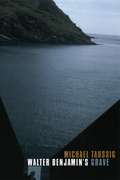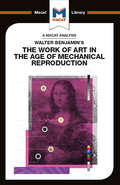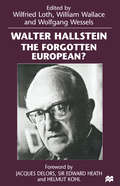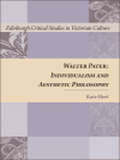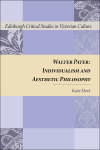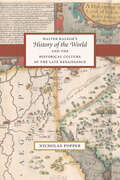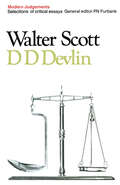- Table View
- List View
Walter Benjamin's Grave
by Michael TaussigIn September 1940, Walter Benjamin committed suicide in Port Bou on the Spanish-French border when it appeared that he and his travelling partners would be denied passage into Spain in their attempt to escape the Nazis. In 2002, one of anthropology’s—and indeed today’s—most distinctive writers, Michael Taussig, visited Benjamin’s grave in Port Bou. The result is “Walter Benjamin’s Grave,” a moving essay about the cemetery, eyewitness accounts of Benjamin’s border travails, and the circumstances of his demise. It is the most recent of eight revelatory essays collected in this volume of the same name. “Looking over these essays written over the past decade,” writes Taussig, “I think what they share is a love of muted and defective storytelling as a form of analysis. Strange love indeed; love of the wound, love of the last gasp.” Although thematically these essays run the gamut—covering the monument and graveyard at Port Bou, discussions of peasant poetry in Colombia, a pact with the devil, the peculiarities of a shaman’s body, transgression, the disappearance of the sea, New York City cops, and the relationship between flowers and violence—each shares Taussig’s highly individual brand of storytelling, one that depends on a deep appreciation of objects and things as a way to retrieve even deeper philosophical and anthropological meanings. Whether he finds himself in Australia, Colombia, Manhattan, or Spain, in the midst of a book or a beach, whether talking to friends or staring at a monument, Taussig makes clear through these marvelous essays that materialist knowledge offers a crucial alternative to the increasingly abstract, globalized, homogenized, and digitized world we inhabit. Pursuing an adventure that is part ethnography, part autobiography, and part cultural criticism refracted through the object that is Walter Benjamin’s grave, Taussig, with this collection, provides his own literary memorial to the twentieth century’s greatest cultural critic.
Walter Benjamin's Grave
by Michael TaussigIn September 1940, Walter Benjamin committed suicide in Port Bou on the Spanish-French border when it appeared that he and his travelling partners would be denied passage into Spain in their attempt to escape the Nazis. In 2002, one of anthropology’s—and indeed today’s—most distinctive writers, Michael Taussig, visited Benjamin’s grave in Port Bou. The result is “Walter Benjamin’s Grave,” a moving essay about the cemetery, eyewitness accounts of Benjamin’s border travails, and the circumstances of his demise. It is the most recent of eight revelatory essays collected in this volume of the same name. “Looking over these essays written over the past decade,” writes Taussig, “I think what they share is a love of muted and defective storytelling as a form of analysis. Strange love indeed; love of the wound, love of the last gasp.” Although thematically these essays run the gamut—covering the monument and graveyard at Port Bou, discussions of peasant poetry in Colombia, a pact with the devil, the peculiarities of a shaman’s body, transgression, the disappearance of the sea, New York City cops, and the relationship between flowers and violence—each shares Taussig’s highly individual brand of storytelling, one that depends on a deep appreciation of objects and things as a way to retrieve even deeper philosophical and anthropological meanings. Whether he finds himself in Australia, Colombia, Manhattan, or Spain, in the midst of a book or a beach, whether talking to friends or staring at a monument, Taussig makes clear through these marvelous essays that materialist knowledge offers a crucial alternative to the increasingly abstract, globalized, homogenized, and digitized world we inhabit. Pursuing an adventure that is part ethnography, part autobiography, and part cultural criticism refracted through the object that is Walter Benjamin’s grave, Taussig, with this collection, provides his own literary memorial to the twentieth century’s greatest cultural critic.
Walter Benjamin's The Work Of Art in the Age of Mechanical Reproduction (The Macat Library)
by Rachele DiniThe Work of Art in the Age of Mechanical Reproduction combats traditional art criticism’s treatment of artworks as fixed, unchanging mystical objects. For Walter Benjamin, the consequences of addressing a work of art in this manner have a wider resonance: closed off from any active visual or tactile engagement, the work of art becomes an object of passive contemplation and a potential tool of oppression. Benjamin argues that technology has fundamentally altered the way art is experienced. Potentially open to interpretation and accessible to many, art in the age of mechanical reproduction has the potential to be mobilized for radical purposes. While ostensibly addressing the artistic consequences of technical reproducibility on art, Benjamin also addresses the wider political consequences of this shift.
Walter Benjamin's The Work Of Art in the Age of Mechanical Reproduction (The Macat Library)
by Rachele DiniThe Work of Art in the Age of Mechanical Reproduction combats traditional art criticism’s treatment of artworks as fixed, unchanging mystical objects. For Walter Benjamin, the consequences of addressing a work of art in this manner have a wider resonance: closed off from any active visual or tactile engagement, the work of art becomes an object of passive contemplation and a potential tool of oppression. Benjamin argues that technology has fundamentally altered the way art is experienced. Potentially open to interpretation and accessible to many, art in the age of mechanical reproduction has the potential to be mobilized for radical purposes. While ostensibly addressing the artistic consequences of technical reproducibility on art, Benjamin also addresses the wider political consequences of this shift.
Walter Besant: The Business of Literature and the Pleasures of Reform (Liverpool English Texts and Studies #76)
In the 1880s and 1890s, Walter Besant was one of Britain’s most lionized living novelists. Like many popular writers of the period, Besant suffered from years of critical neglect. Yet his centrality to Victorian society and culture all but ensured a revival of interest. While literary critics are now rediscovering the more than forty works of fiction that he penned or co-wrote, as part of a more general revaluation of Victorian popular literature, legal scholars have argued that Besant, by advocating for copyright reform, played a crucial role in consolidating a notion of literary property as the exclusive possession of the individuated intellect. For their part, historians have recently shown how Besant – as a prominent philanthropist who campaigned for the cultural vitalization of impoverished areas in east and south London – galvanized late Victorian social reform activities. The expanding corpus of work on Besant, however, has largely kept the domains of authorship and activism, which he perceived as interrelated, conceptually distinct. Analysing the mutually constitutive interplay in Besant’s career between philanthropy and the professionalization of authorship, Walter Besant: The Business of Literature and the Pleasures of Reform highlights their fundamental interconnectedness in this Victorian intellectual polymath’s life and work.
Walter de la Mare: Critical Appraisals (Liverpool English Texts and Studies #95)
This book aims to put Walter de la Mare back on the literary map. A writer beloved by many, he has nevertheless remained on the sidelines of literary history. Walter de la Mare: Critical Appraisals promises to restore his reputation as one of the most memorably haunting of poets, as well as a peculiarly unnerving writer of ghost stories. A collection of varied, wide-ranging essays on de la Mare’s poetry, stories, novels, reviews and lectures, it puts his work beside that of many of his famous contemporaries, including Thomas Hardy, Robert Frost, W. H. Auden, T. S. Eliot and Katherine Mansfield. It also contains an invaluable survey of his archive, much of it unpublished, and a number of newly commissioned poems reflecting on his legacy. This multifaceted volume will be of interest to students working on twentieth-century poetry, the short story, the nature and limits of modernism and British intellectual history, as well as on de la Mare himself.List of contributors: Catherine Charlwood, Guy Cuthbertson, Peter Davidson, Giles de la Mare, Andrew Doyle, Suzannah V. Evans, Adam Guy, Robin Holloway, Yui Kajita, Zaffar Kunial, Gregory Leadbetter, Angela Leighton, Erica McAlpine, Jenny McDonnell, Will May, Andrew Motion, Paul Muldoon, A. J. Nickerson, Seamus Perry, Adrian Poole, Camille Ralphs, Vidyan Ravinthiran, Peter Scupham, A. E. Stallings, Mark Valentine, Rory Waterman, Anne Welsh, David Wheatley, Rowan Williams, William Wootten.
Walter Greenwood’s 'Love on the Dole': Novel, Play, Film (Liverpool English Texts and Studies #71)
by Chris HopkinsLove on the Dole (1933), the iconic novel about 1930s British working-class life, has a significant place in British cultural history. Its author, Walter Greenwood, went from unemployed Salford man to best-selling writer, and the novel has never been out of print. The 1935 stage adaptation was said to have been seen by three million people by 1940, including the King and Queen. Greenwood proposed a film adaption in 1936, but the story was pronounced too ‘sordid’ and depressing’ by the British Board of Film Censors. However, in 1940 the Ministry of Information decided that this story of pre-war economic and social failure should be filmed as a contribution to the ‘people’s war’. It was widely regarded as one of the best British wartime productions – and all three versions of Love on the Dole were frequently referenced during wartime debate about how a reconstructed post-war society should make a repetition of the 1930s impossible.This study explores in detail what made this important text so influential, analyses the considerable differences between the novel, play and film versions and places the public response to Love on the Dole in its full historical context. It examines Greenwood’s whole literary career and his continuing success until the 1960s: casting new light on his subsequent novels, plays and non-fiction works, few of which have received critical attention.
Walter Hallstein: The Forgotten European?
by Wilfried Loth William Wallace Wolfgang Wessels Trans Bryan RuppertWalter Hallstein was among the great European visionaries. This is the first book length study of one of the key shapers of the European Community in its early years. The range of contributors include those who worked with Hallstein and have personal recollections of him, and younger historians drawing upon documents only recently available. The book contains sections on his contribution as State Secretary to post-war German foreign policy, his seminal role as the first President of the Commission of the EEC and the legacy of his work and ideas and later years as President of the European Movement.
Walter Hawkesworth's Labyrinthus: An Edition with a Translation and Commentary Volume II (Routledge Revivals)
by Walter HawesworthOriginally compiled and published in 1988, this vole contains the full text and translation of Walter Hawkesworth's Labyrinthus, alongside textual and critical notes, including essays on the author, the staging and the style and language. This is the second of two volumes.
Walter Hawkesworth's Labyrinthus: An Edition with a Translation and Commentary Volume II (Routledge Revivals)
by Walter HawesworthOriginally compiled and published in 1988, this vole contains the full text and translation of Walter Hawkesworth's Labyrinthus, alongside textual and critical notes, including essays on the author, the staging and the style and language. This is the second of two volumes.
Walter Hawkesworth's Labyrinthus: An Edition with a Translation and Commentary Volume I (Routledge Revivals)
by Walter HawkesworthOriginally compiled and published in 1988, this vole contains the full text and translation of Walter Hawkesworth's Labyrinthus, alongside textual and critical notes, including essays on the author, the staging and the style and language. This is the first of two volumes.
Walter Hawkesworth's Labyrinthus: An Edition with a Translation and Commentary Volume I (Routledge Revivals)
by Walter HawkesworthOriginally compiled and published in 1988, this vole contains the full text and translation of Walter Hawkesworth's Labyrinthus, alongside textual and critical notes, including essays on the author, the staging and the style and language. This is the first of two volumes.
Walter Höllerer: Poetologische und literaturgeschichtliche Schriften 1952–1986
Walter Höllerer (1922–2003) gestaltete als Mitglied der Gruppe 47 und langjähriger Mitherausgeber der Zeitschrift Akzente maßgeblich die Modernisierung der deutschen Literatur in der zweiten Hälfte des 20. Jahrhunderts. Er gründete das Institut und die Zeitschrift Sprache im technischen Zeitalter sowie das Literarische Colloquium Berlin, gab wegweisende Anthologien wie Transit oder Junge amerikanische Lyrik heraus und organisierte Veranstaltungen, die den modernen Literaturbetrieb prägten. Seinen Schriften lassen sich zentrale Veränderungen des Literaturbegriffs im Übergang von der Nachkriegs- zur Gegenwartsliteratur ablesen. Anlässlich seines 100. Geburtstages und 20. Todestages präsentiert die Edition eine Auswahl der poetologischen und literaturgeschichtlichen Texte Walter Höllerers.
Walter Pater: Individualism and Aesthetic Philosophy (Edinburgh Critical Studies in Victorian Culture (PDF))
by Kate HextRepositioning Walter Pater at the philosophical nexus of Aestheticism, this study presents the first discussion of how Pater redefines Romantic Individualism through his engagements with modern philosophical discourses and in the context of emerging modernity in Britain. It also considers the dynamics between form and thought at the fin de siècle, contextualizing its comments in terms of Matthew Arnold, Oscar Wilde and Vernon Lee and others, to offer a fully integrated account of the intellectual cultures and currents in this period.
Walter Pater: Individualism and Aesthetic Philosophy (Edinburgh Critical Studies in Victorian Culture (PDF))
by Kate HextRepositioning Walter Pater at the philosophical nexus of Aestheticism, this study presents the first discussion of how Pater redefines Romantic Individualism through his engagements with modern philosophical discourses and in the context of emerging modernity in Britain.
Walter Pater and Persons
by Stephen CheekeWalter Pater and Persons investigates the vital concept of the Person in the work of Walter Pater, a major influence on late nineteenth- and early twentieth-century literature. Stephen Cheeke explores the intersections of the person, persona, and personality in Pater's work; re-examines arguments about his famously personal prose style; traces Pater's ambivalent fascination with impersonality and asceticism; considers the poetics of personification in his writings about Greek myth and religion, in the divine logos of early Christianity, and in the theory of Platonic Universals; and explores his fascination with metempsychosis (the many persons through whom the individual soul transmigrates). Cheeke also explores the networks in which Pater was interpreted and misinterpreted by different persons and personalities, such as Oscar Wilde, Arthur Symons, and W.B Yeats. Their (mis)readings of Pater, and rebellions against his work from Decadent, antinomian, and 'mystical' perspectives, reveal the ways in which Pater's writing had always been in a critical dialogue with its own thinking, as well as a prescient one in relation to his reception. The philosophical question of 'what is a person?'--a crucial one for the nineteenth century, and with an increasing urgency in our own times--is illuminated throughout this work.
Walter Ralegh's "History of the World" and the Historical Culture of the Late Renaissance
by Nicholas PopperImprisoned in the Tower of London after the death of Queen Elizabeth in 1603, Sir Walter Ralegh spent seven years producing his massive History of the World. Created with the aid of a library of more than five hundred books that he was allowed to keep in his quarters, this incredible work of English vernacular would become a best seller, with nearly twenty editions, abridgments, and continuations issued in the years that followed. Nicholas Popper uses Ralegh’s History as a touchstone in this lively exploration of the culture of history writing and historical thinking in the late Renaissance. From Popper we learn why early modern Europeans ascribed heightened value to the study of the past and how scholars and statesmen began to see historical expertise as not just a foundation for political practice and theory, but as a means of advancing their power in the courts and councils of contemporary Europe. The rise of historical scholarship during this period encouraged the circulation of its methods to other disciplines, transforming Europe’s intellectual—and political—regimes. More than a mere study of Ralegh’s History of the World, Popper’s book reveals how the methods that historians devised to illuminate the past structured the dynamics of early modernity in Europe and England.
Walter Ralegh's "History of the World" and the Historical Culture of the Late Renaissance
by Nicholas PopperImprisoned in the Tower of London after the death of Queen Elizabeth in 1603, Sir Walter Ralegh spent seven years producing his massive History of the World. Created with the aid of a library of more than five hundred books that he was allowed to keep in his quarters, this incredible work of English vernacular would become a best seller, with nearly twenty editions, abridgments, and continuations issued in the years that followed. Nicholas Popper uses Ralegh’s History as a touchstone in this lively exploration of the culture of history writing and historical thinking in the late Renaissance. From Popper we learn why early modern Europeans ascribed heightened value to the study of the past and how scholars and statesmen began to see historical expertise as not just a foundation for political practice and theory, but as a means of advancing their power in the courts and councils of contemporary Europe. The rise of historical scholarship during this period encouraged the circulation of its methods to other disciplines, transforming Europe’s intellectual—and political—regimes. More than a mere study of Ralegh’s History of the World, Popper’s book reveals how the methods that historians devised to illuminate the past structured the dynamics of early modernity in Europe and England.
Walter Ralegh's "History of the World" and the Historical Culture of the Late Renaissance
by Nicholas PopperImprisoned in the Tower of London after the death of Queen Elizabeth in 1603, Sir Walter Ralegh spent seven years producing his massive History of the World. Created with the aid of a library of more than five hundred books that he was allowed to keep in his quarters, this incredible work of English vernacular would become a best seller, with nearly twenty editions, abridgments, and continuations issued in the years that followed. Nicholas Popper uses Ralegh’s History as a touchstone in this lively exploration of the culture of history writing and historical thinking in the late Renaissance. From Popper we learn why early modern Europeans ascribed heightened value to the study of the past and how scholars and statesmen began to see historical expertise as not just a foundation for political practice and theory, but as a means of advancing their power in the courts and councils of contemporary Europe. The rise of historical scholarship during this period encouraged the circulation of its methods to other disciplines, transforming Europe’s intellectual—and political—regimes. More than a mere study of Ralegh’s History of the World, Popper’s book reveals how the methods that historians devised to illuminate the past structured the dynamics of early modernity in Europe and England.
Walter Ralegh's "History of the World" and the Historical Culture of the Late Renaissance
by Nicholas PopperImprisoned in the Tower of London after the death of Queen Elizabeth in 1603, Sir Walter Ralegh spent seven years producing his massive History of the World. Created with the aid of a library of more than five hundred books that he was allowed to keep in his quarters, this incredible work of English vernacular would become a best seller, with nearly twenty editions, abridgments, and continuations issued in the years that followed. Nicholas Popper uses Ralegh’s History as a touchstone in this lively exploration of the culture of history writing and historical thinking in the late Renaissance. From Popper we learn why early modern Europeans ascribed heightened value to the study of the past and how scholars and statesmen began to see historical expertise as not just a foundation for political practice and theory, but as a means of advancing their power in the courts and councils of contemporary Europe. The rise of historical scholarship during this period encouraged the circulation of its methods to other disciplines, transforming Europe’s intellectual—and political—regimes. More than a mere study of Ralegh’s History of the World, Popper’s book reveals how the methods that historians devised to illuminate the past structured the dynamics of early modernity in Europe and England.
Walter Ralegh's "History of the World" and the Historical Culture of the Late Renaissance
by Nicholas PopperImprisoned in the Tower of London after the death of Queen Elizabeth in 1603, Sir Walter Ralegh spent seven years producing his massive History of the World. Created with the aid of a library of more than five hundred books that he was allowed to keep in his quarters, this incredible work of English vernacular would become a best seller, with nearly twenty editions, abridgments, and continuations issued in the years that followed. Nicholas Popper uses Ralegh’s History as a touchstone in this lively exploration of the culture of history writing and historical thinking in the late Renaissance. From Popper we learn why early modern Europeans ascribed heightened value to the study of the past and how scholars and statesmen began to see historical expertise as not just a foundation for political practice and theory, but as a means of advancing their power in the courts and councils of contemporary Europe. The rise of historical scholarship during this period encouraged the circulation of its methods to other disciplines, transforming Europe’s intellectual—and political—regimes. More than a mere study of Ralegh’s History of the World, Popper’s book reveals how the methods that historians devised to illuminate the past structured the dynamics of early modernity in Europe and England.
Walter Ralegh's "History of the World" and the Historical Culture of the Late Renaissance
by Nicholas PopperImprisoned in the Tower of London after the death of Queen Elizabeth in 1603, Sir Walter Ralegh spent seven years producing his massive History of the World. Created with the aid of a library of more than five hundred books that he was allowed to keep in his quarters, this incredible work of English vernacular would become a best seller, with nearly twenty editions, abridgments, and continuations issued in the years that followed. Nicholas Popper uses Ralegh’s History as a touchstone in this lively exploration of the culture of history writing and historical thinking in the late Renaissance. From Popper we learn why early modern Europeans ascribed heightened value to the study of the past and how scholars and statesmen began to see historical expertise as not just a foundation for political practice and theory, but as a means of advancing their power in the courts and councils of contemporary Europe. The rise of historical scholarship during this period encouraged the circulation of its methods to other disciplines, transforming Europe’s intellectual—and political—regimes. More than a mere study of Ralegh’s History of the World, Popper’s book reveals how the methods that historians devised to illuminate the past structured the dynamics of early modernity in Europe and England.
Walter Scott (Routledge Library Editions: The Nineteenth-Century Novel)
by Robin MayheadFirst published in 1968, this study is an exciting and challenging introduction to the writings of Sir Walter Scott. The author discusses the more striking features of Scott’s style — his use of language and characterisation — and also evaluates the contemporary moral and political attitudes portrayed in the novels. The use of literary conventions of the time is examined with reference to Scott’s work and extracts exemplify in particular the use of the Heroic. While admitting Scott’s faults as a writer, the author presents a general view of him as one whose works deserve deeper study than was the prevailing opinion at the time. This book will be of interest to students of literature.
Walter Scott (Routledge Library Editions: The Nineteenth-Century Novel)
by Robin MayheadFirst published in 1968, this study is an exciting and challenging introduction to the writings of Sir Walter Scott. The author discusses the more striking features of Scott’s style — his use of language and characterisation — and also evaluates the contemporary moral and political attitudes portrayed in the novels. The use of literary conventions of the time is examined with reference to Scott’s work and extracts exemplify in particular the use of the Heroic. While admitting Scott’s faults as a writer, the author presents a general view of him as one whose works deserve deeper study than was the prevailing opinion at the time. This book will be of interest to students of literature.
